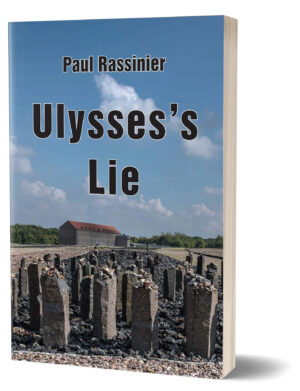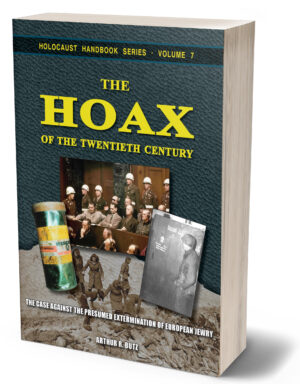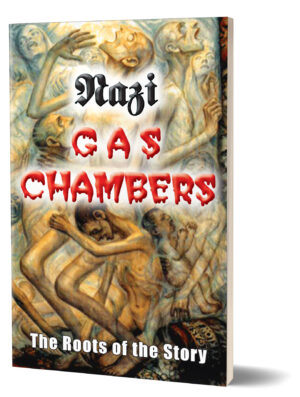Who Put the Gas into the Chambers?
On the Roots of the Nazi Gas-Chamber Story
The Question
Most Holocaust skeptics agree that the story about homicidal gas chambers used during the Third Reich to mass murder Jews is bogus. What they don’t agree on is how that bogus history ended up in our history text books, documentaries and museums. If the story doesn’t stand up to thorough scrutiny, then why did it end up dominating the mainstream Holocaust narrative to the degree it does? In other words: Who put the gas chambers into that narrative, and how?

Mainstream pundits are quick to react to any onslaught on their favorite dogma by those evil “Holocaust deniers” that they are conspiracy theorist claiming that thousands upon thousands of Jews scattered throughout war-torn Europe somehow plotted to frame the poor Germans for this evil crime by “an incredible meeting of minds, a consensus mind reading by a far-flung” Jewish diaspora – to rephrase a famous expression used by the late Raul Hilberg to describe how the Holocaust came about.
Is that how it happened? Or at least, is that what Holocaust skeptics claim happened?
Previous Answers
Paul Rassinier, the father of Holocaust revisionism, reported from his own experience that political prisoners held in German concentration camps were the ones who dominated how the history of these camps was written after the war. Distortions of this history were to a large degree the result of an attempt by these former inmates to hide their co-responsibilities for the real horrors of these camps, as the political prisoner Rassinier experienced them at the Buchenwald and Dora camps. As Rassinier explains, political activists commonly are intellectuals who know how to organize crowds and how to induce people to follow orders. When such individuals ended up in German wartime camps, they got organized and quickly dominated the camp-internal administration that was maintained considerably by collaborating inmates. Once wielding positions of power over their co-inmates, they abused that power, thus increasing the sufferings of their less-fortunate fellow prisoners. However, Rassinier’s observations do not get us to the core of our topic, because neither of the camps he suffered through had homicidal gas chambers. Therefore, Rassinier’s experience does not cover that crucial part of the Holocaust narrative. Yet still, even his later writings where he addresses the gas-chamber question do not contain a claim of a Jewish conspiracy.

A major steppingstone for the development of Holocaust skepticism was Dr. Arthur R. Butz’s epochal study The Hoax of the Twentieth Century. Butz’s focus is to a large degree on Allied post-war tribunals conducted in Germany after the war, which were heavily dominated (International Military Tribunal) or conducted exclusively (Nuremberg Military Tribunals) by judicial and military forces of the United States. Butz shows the heavy influence Jewish individuals had on how these trials were set up and prepared. However, the International Military Tribunal dealt with the “Holocaust” only in a rather superficial way, while only one of the Nuremberg Military Tribunals addressed a subtopic of this much larger issue: Case No. 9 against Otto Ohlendorf and others, which addressed the claimed mass shooting by the Einsatzgruppen as well as their alleged use of homicidal gas vans for mass executions. The prosecution’s case rested almost entirely on documents, with no survivor witnesses ever taking the stand, whether Jewish or otherwise. Stationary gas chambers were not addressed in any of these trials in any manner that could be called influential on how the narrative eventually coalesced into what we are taught and told today throughout our society.
Another revisionist attempt at giving an answer to the question of Whodunit was published in 1988 by US-American translator Carlos Porter. His book carried the indicative title Made in Russia: The Holocaust. Porter basically copied pages from the IMT’s protocol, predominantly from Volume 7, which contains material introduced by Soviet prosecutors during that tribunal. While a lot of it is today considered false atrocity propaganda even by most mainstream historians, little of it addresses the issue of homicidal gas chambers. In fact, much of the material submitted by the Soviets during the IMT referring to execution chambers does not mention gas at all, but rather steam, vacuum and high-voltage electricity. Hence, there was little if any gas in the chambers presented by the Soviets at Nuremberg, and none of it went into any detail.

The most prolific of all revisionist authors – Italian scholar Carlo Mattogno – never addresses the issue discussed here. While his truly impressive body of historical research contains massive amounts of detailed information about a broad variety of topics, it is completely silent as to how and by whom the current gas-chamber narrative was formed as a whole.
So, then, who put the gas into the chambers?
A New Approach
I have been involved in Holocaust revisionist research and publication for more than 30 years. During all these years, I have avoided facing the question of this paper, let alone attempting to answer it. The reason for this is that I feared that any answer to that question might inevitably to one degree or another point to “the Jews.” And the last thing I wanted to do is contribute to the mainstream cliché that Holocaust skeptics are anti-Jewish lunatics claiming some ludicrous Jewish conspiracy to invent false history. I was trying to understand what happened, but when it came to how the narrative we know today came to be, I was intentionally not looking into who was dominating the formation of this narrative.
Since the Nazi homicidal gas chambers are said to have been purpose-built and ‑deployed to exterminate Jews, it is inevitable that most witnesses from the victim side of the Holocaust have a Jewish background. Also, if we look at the pundits who have created books, movies and museums on the Holocaust, and who have defined and run Holocaust-study courses ever since the end of the war, we find a huge predominance of people with a Jewish background. We could leave it at that and move one. But it is not that simple.
While I was writing the Holocaust Encyclopedia (see www.HolocaustEncyclopedia.com), I had a number of epiphanies resulting from the fact that I had to get so many facts straight, and make everything consistent and coherent. I started connecting dots between seemingly isolated facts which I had never seen before. One of them was the realization that there was actually a plot to create the orthodox gas-chamber narrative as we know it today. That conspiracy is not what most people think it is, though, because it has nothing to do with Jews at all. You hear me right: not a single Jew was involved. That realization was a huge relief for me. Not only was it possible to understand what happened, but also to avoid the awful charge of indifferently blaming it all on “the Jews,” and thus being seen as a deranged lunatic by society at large.
Carlos Porter could have seen some part of this revelation, if he had dug a little deeper into what the Soviets presented at Nuremberg. When it comes to the Nazi gas chambers, many of the core documents they introduced had been prepared by Polish authorities. Since the Polish government was not represented at the IMT, they had to use their occupational power USSR as a proxy.
Furthermore, a simple look at where all the homicidal gas chambers are said to have been located where mass-murder of Jews is said to have happened is just as revealing: Without a single exception, they are all located on what is today considered Polish territory: Auschwitz, Bełżec, Chełmno, Majdanek, Sobibór, Stutthof, Treblinka.
In his many studies about these camps, Carlo Mattogno has documented who interrogated the witnesses after the war; who conducted forensic examinations at those camps; who investigated these camp’s documentation; who conducted trials against former camp guards where all this evidence was presented; and who published academic papers which presented the alleged results of all this historical and judicial research. Without a single exception, they were all Poles.
Looking closer, we find just four individuals who defined the narrative of six of the above camps that are central for the Nazi gas-chamber narrative. (I omit Stutthof here, because it has always been an obscure camp not playing any major role in the larger Holocaust narrative.) These narratives were published in Polish academic periodicals between 1946 and 1948 (Belzec, Chełmno, Majdanek, Sobibór, Treblinka), as well as in the later 1950s and first half of the 1960s (Auschwitz).
These individuals are:
- Jan Sehn (Auschwitz)
- Władysław Bednarz (Chełmno)
- Zdzisław Łukaszkiewicz (Majdanek, Sobibór, Treblinka)
- Eugeniusz Szrojt (Bełżec).
As far as I could determine, none of them had a Jewish background.
How exactly they went about to rig the historical record to come out with a seemingly consistent gas-chamber narrative is described in detail in my new book Nazi Gas Chambers: The Roots of the Story. To summarize it succinctly, they took the total anarchy that reigned among evidently non-harmonized, non-orchestrated, non-coordinated, in fact to a large degree non-sensical eyewitness accounts and replaced it with a deus ex machina of an invented story that is not at all supported by the evidence. It was a machete approach to historiography: hack down and throw out everything that stands in the way of a walkable path, and then claim that the path has been there all along.
After 1948, the victorious powers of World War II temporarily lost interest in pushing the Holocaust narrative, because both sides of the Iron Curtain wanted to recruit “their” Germans as potential brain power and cannon fodder for the fledgling Cold War. Israel was created in 1948, but initially wasn’t organized enough yet to play any significant role in the creation of anything. Most Jewish organizations and personalities particularly in the U.S. tried to keep a low profile through the early hot phase of the Cold War with its McCarthy era, in an attempt to deflect possible charges of treason during wartime and postwar collaboration with, and spying for, Stalin’s Soviet Union.

But the communist authorities of postwar Poland were on a mission. 50% of Poland’s postwar territory used to be German before World War One, and the vast majority of it had been inhabited by ethnic Germans for centuries. In 1945 and 1946, these lands were wiped clean of everything German during the largest ethnic cleansing of modern history (see the illustration). Something needed to be done in order to prevent Germany from ever demanding justice and restitution. Breaking Germany’s pride and self-confidence by burdening that nation with the most-heinous crime of the history of mankind was the perfect solution.
And so it was done. We do not know whether, and if so to what degree, it was done following some centrally perceived and instituted plan. That is a question to be addressed by future research.
At any rate, once Polish state-sponsored historians in combination with that country’s judiciary managed to get the gravy train moving, many opportunists, Jews and Gentiles alike, jumped on it.

Get Your Own Copy of this Truly Mind-Blowing Book
Germar Rudolf, Nazi Gas Chambers: The Roots of the Story, Armreg Ltd., London, 2024, 146 pages, 8”×5” paperback, index, bibliography; ISBN: 978-1-911733-96-6.
Nazi gas chambers are the iconic core of the Holocaust narrative. Millions of Jews were killed in them with poison gas, we are told. However, if we dig deeper, we find early accounts that tell a different story: steam, vacuum and electrocution chambers, murder with chlorinated lime in trains, or with toxic fluids. How did we get from these bizarre claims to what we are told today? This book reveals who cleansed the historical record to create an apparently consistent and coherent narrative, and which methods were used in the process. Those looking for evidence of a huge Jewish conspiracy, however, will be disappointed, because that’s not how it happened. Instead, the details of the conventional gas-chamber story were defined and documented by… well, read the book and find out!
For more details, see the book announcement at the end of this issue.
Bibliographic information about this document: Inconvenient History, 2024, Vol. 16, No. 3
Other contributors to this document:
Editor’s comments:
